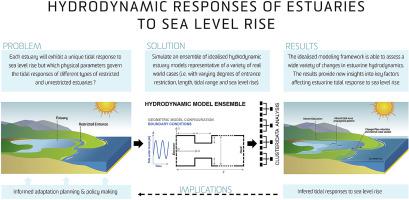Estuarine, Coastal and Shelf Science ( IF 2.6 ) Pub Date : 2020-07-30 , DOI: 10.1016/j.ecss.2020.106941 Danial Khojasteh , Steve Hottinger , Stefan Felder , Giovanni De Cesare , Valentin Heimhuber , David J. Hanslow , William Glamore

|
Estuarine environments, as dynamic low-lying transition zones between rivers and the open sea, are vulnerable to sea level rise (SLR). To evaluate the potential impacts of SLR on estuarine responses, it is necessary to examine the altered tidal dynamics, including changes in tidal amplification, dampening, reflection (resonance), and deformation. Moving beyond commonly used static approaches, this study uses a large ensemble of idealised estuarine hydrodynamic models to analyse changes in tidal range, tidal prism, phase lag, tidal current velocity, and tidal asymmetry of restricted estuaries of varying size, entrance configuration and tidal forcing as well as three SLR scenarios. For the first time in estuarine SLR studies, data analysis and clustering approaches were employed to determine the key variables governing estuarine hydrodynamics under SLR. The results indicate that the hydrodynamics of restricted estuaries examined in this study are primarily governed by tidal forcing at the entrance and the estuarine length. In addition, SLR increases the average water depth and alters the nodal point location in a seaward direction, thereby significantly affecting tidal wave propagation patterns and reducing the degree of flood domination. In estuaries with restricted entrances, tidal range diminishes drastically in the restricted zone by 20–60%, and the maximum tidal current velocity is higher in the restricted part but lower in the upstream part compared to unrestricted estuaries. For estuary types examined, inundation extent under SLR will likely be greater than the extent expected through simply adjusting existing water levels upwards. The findings also underline that an engineered entrance restriction could regulate tidal wave propagation within an estuary to offset SLR induced tidal range amplification. However, this may pose additional management challenges.
中文翻译:

河口潮汐对海平面上升的响应:入口限制的意义
河口环境是河流和公海之间动态低洼的过渡区域,容易受到海平面上升(SLR)的影响。为了评估SLR对河口响应的潜在影响,有必要检查潮汐动力学的变化,包括潮汐放大,衰减,反射(共振)和变形的变化。除常用的静态方法外,本研究还使用大量理想的河口水动力模型来分析尺寸,入口构造和潮汐力变化的受限河口的潮差,潮汐棱镜,相位滞后,潮汐流速和潮汐不对称性的变化。以及三种单反场景。在河口SLR研究中,数据分析和聚类方法被用来确定控制SLR下河口水动力的关键变量。结果表明,本研究中研究的受限河口的水动力主要受入口处的潮汐强迫和河口长度的控制。此外,SLR增加了平均水深并改变了向海方向的节点位置,从而显着影响了潮汐波的传播方式并降低了洪水控制的程度。在入口受限的河口中,限制区域的潮汐范围急剧减小了20-60%,与非限制河口相比,最大潮汐流速在限制区域较高,而在上游区域较低。对于检查的河口类型,通过简单地向上调整现有水位,SLR下的淹没程度可能会大于预期的程度。研究结果还强调,工程设计的入口限制措施可以调节河口内的潮波传播,以抵消SLR引起的潮差放大。但是,这可能会带来其他管理挑战。











































 京公网安备 11010802027423号
京公网安备 11010802027423号